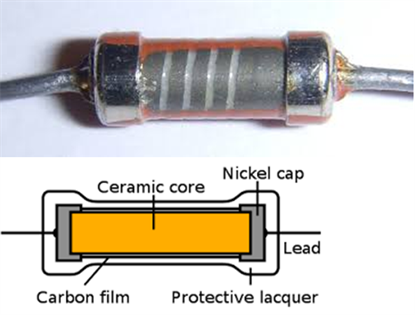The carbon resistor is the most common form of resistor used in electronics. They are made of a sturdy cylindrical resistive element with embedded wire leads or metal end caps.
Carbon resistors come in a range of physical sizes and power dissipation limits ranging from 1 watt to 1/8 watt.
The basic resistor colour code can be used to calculate the resistance value and tolerance.
Index
History
Carbon composition resistors have been used for hundreds of years. Resistors were manufactured without insulation at the beginning of the twentieth century.
The lead wires were soldered directly to the resistor body. Before the 1960s, the only resistor forms available were wirewound and carbon composition.
Carbon composition resistors were discontinued out in the 1960s and 1970s in favour of other forms such as carbon or metal film resistors.
Symbol of Carbon Resistor
The symbol of a carbon resistor of resistance R is

Structure of Carbon Resistor
The different parts of a carbon resistor are:
- Ceramic Core
- Nickel Cap
- Lead
- Carbon Film
- Protective Lacquer
Its internal structure is shown in the diagram below:

Construction of Carbon Resistor
Following is the procedure involved in the construction of a this resistor
- Carbon is coated onto a ceramic core of the carbon resistor. The deposited carbon is painted with a spiral, transforming it into a wire wrapped around a ceramic core.
- The pitch, diameter, and length of the carbon spiral differ depending on the appropriate resistance.
- Nickel caps are applied to both ends of the core to ensure that the carbon and lead make proper contact.
- For electrical insulation, the leads are soldered to the nickel caps, and the entire resistor is covered with lacquer.
- Metal caps serve as heating elements to carry away heat dissipated by the resistor when small resistances are needed for small currents.
Applications of Carbon Resistor
- Carbon composition resistors can tolerate high-energy pulses while remaining small in scale. As a result, the carbon composition resistor is still used in a variety of applications today.
- Circuit protection (surge or discharge protection), current limitation, high voltage power supplies, high power or strobe lighting, and welding are some of the applications.
- A medical defibrillator is one example of an application. The critical measuring instruments attached to the patient must be protected from high energy pulses of approximately 30 Joule.
- Carbon-composite resistors are used in devices and must withstand all pulse energy.
FAQs
The resistance (R) of a resistor depends on its resistivity (material it is made of), thickness, and cross-sectional area.
Tolerance is the percentage of error in a resistor’s resistance, or how much greater or less a resistor’s real measured resistance can be expected to be from its specified resistance.
A gold tolerance band represents a 5% tolerance, a silver tolerance band represents a 10% tolerance, and no band at all represents a 20% tolerance.
A battery is an actual voltage source. A battery can be seen as an ideal voltage source with a small resistor attached.
So, the battery and resistor are not the same
